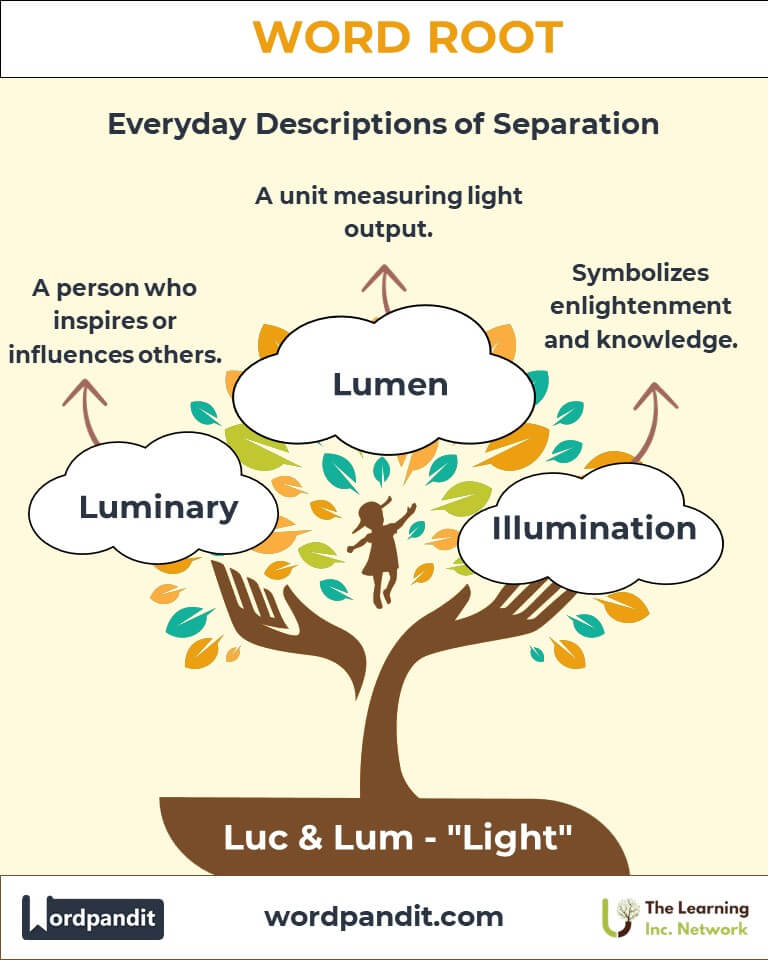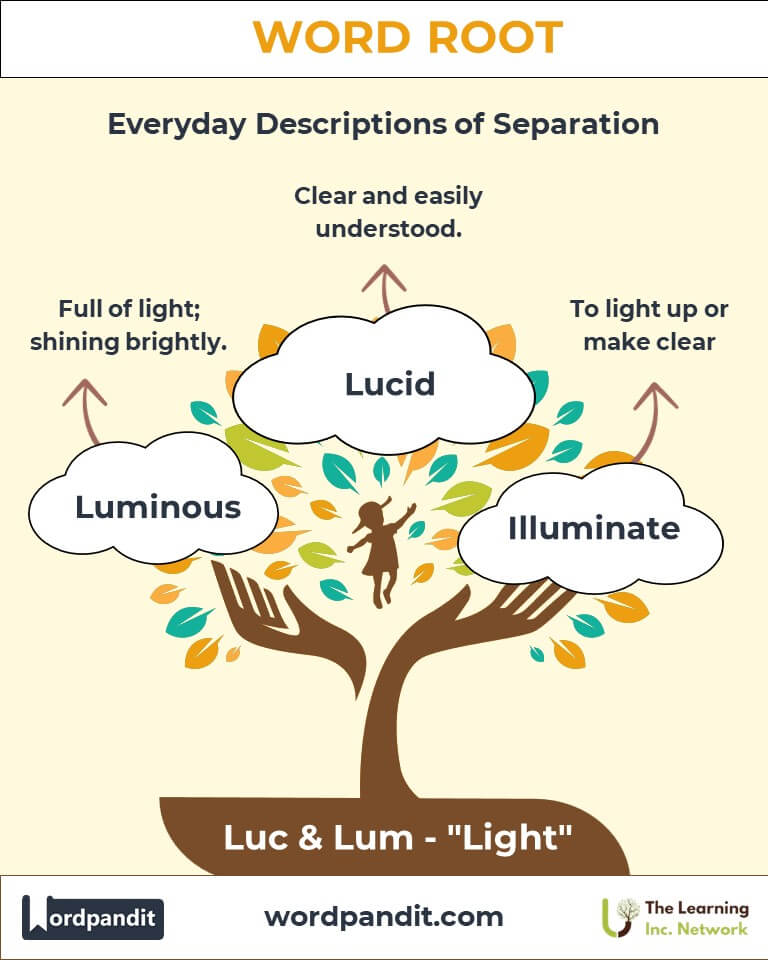Luc & Lum: Illuminating Language and Ideas Across Fields
Byline: Delve into the roots "luc" and "lum," stemming from Latin words for "light," and discover their radiant impact on language and expression. From "luminous" to "lucid," these roots brighten everyday vocabulary and specialized fields alike, embodying the essence of clarity and brilliance.

Table of Contents
- Introduction: The Glow of Luc & Lum
- Etymology and Historical Journey
- Mnemonic: Remembering Luc & Lum
- Common Luc & Lum-Related Terms
- Luc & Lum Through Time
- Luc & Lum in Specialized Fields
- Illustrative Story: Luc & Lum in Action
- Cultural Significance of Luc & Lum
- The Luc & Lum Family Tree
- FAQs about the Luc & Lum Word Roots
- Test Your Knowledge: Luc & Lum Mastery Quiz
- Conclusion: The Everlasting Glow of Luc & Lum
Introduction: The Glow of Luc & Lum
Imagine a candle in a dark room, casting light and revealing clarity in the shadows. The Latin roots "luc" and "lum," meaning "light," mirror this imagery, symbolizing illumination in thought, vision, and understanding. These roots enrich words used in daily life and specialized contexts, highlighting the universal significance of light as a metaphor for knowledge and clarity.

Etymology and Historical Journey
"Luc" and "lum" trace their origins to the Latin "lux" (light) and "lumen" (light, lamp). These roots entered English through French during the Norman Conquest and became central to terms describing brightness and clarity, both literal and figurative. Over time, they evolved to encapsulate concepts of understanding, inspiration, and brilliance.
Mnemonic: Remembering Luc & Lum
Visualize a glowing light bulb labeled "LUC/LUM" in a dark room, with beams of light spelling words like "illuminate" and "lucid." This image captures their core essence—bringing light and clarity.
Mnemonic Device: "Luc and Lum light the way to clarity, from luminous lamps to lucid thoughts."
Common Luc & Lum-Related Terms
- Luminous (loo-muh-nuhs): Full of light; shining brightly.
- Example: "The moon was luminous against the night sky."
- Lucid (loo-sid): Clear and easily understood.
- Example: "Her explanation of the theory was remarkably lucid."
- Illuminate (ih-loo-muh-nate): To light up or make clear.
- Example: "The teacher used a metaphor to illuminate the complex concept."
- Luminary (loo-muh-ner-ee): A person who inspires or influences others, often in a specific field.
- Example: "She was a luminary in the world of science."
- Translucent (trans-loo-suhnt): Allowing light to pass through but not detailed images.
- Example: "The translucent curtains bathed the room in soft sunlight."
Luc & Lum Through Time
- Lucida (Historic): A term in astronomy referring to the brightest star in a constellation, emphasizing the root's connection to brilliance.
- Illuminati (Historic): Once referring to enlightened individuals, now associated with secret societies, showcasing the figurative use of "light."
- Lumen (Modern Science): A unit measuring light output, showing the transition from metaphorical to scientific application.
Luc & Lum in Specialized Fields
- Medicine:
- Lumen: Refers to the cavity within a tubular structure, such as a blood vessel.
- Physics:
- Luminous Flux: Measures the perceived brightness of a light source.
- Literature:
- Lucidity: Denotes clarity in writing or thought.
- Philosophy:
- Illumination: Symbolizes enlightenment and the pursuit of knowledge.
Illustrative Story: Luc & Lum in Action
In a bustling city, a young artist named Lucy used translucent paints to create luminous landscapes that seemed to glow from within. Meanwhile, her brother Luke, a physicist, developed a revolutionary luminary device to bring light to remote villages. Together, their efforts illuminated the world—Lucy through art and Luke through innovation—showing how "luc" and "lum" shine across disciplines.
Cultural Significance of Luc & Lum
The roots "luc" and "lum" hold cultural weight as symbols of hope, knowledge, and revelation. From the Enlightenment era's focus on reason ("Age of Light") to the literal use of light in art and cinema, these roots remind us of humanity’s eternal quest for clarity and understanding.

The Luc & Lum Family Tree
- Lux (Latin: Light):
- Example: "Luxurious" (originally denoting brightness and splendor).
- Photo (Greek: Light):
- Example: "Photography" (light writing).
- Cand (Latin: To shine):
- Example: "Candid" (open and shining in honesty).

FAQs About the Luc & Lum Word Roots
Q: What do "luc" and "lum" mean?
A: "Luc" and "lum" mean "light," derived from the Latin roots lux (light) and lumen (lamp, light source). These roots symbolize both physical light (e.g., luminous objects) and metaphorical light (e.g., clarity or understanding).
Q: Are "luc" and "lum" always related to visible light?
A: No, they are also used metaphorically. For example, "lucid" refers to clarity of thought or expression, while "illuminate" can mean to make an idea or concept clear, not just to light up physically.
Q: What is a luminary, and why is it metaphorical?
A: A luminary is a person who is an inspiration or leader in their field, metaphorically shining light with their influence or knowledge. This figurative use emphasizes their role in "illuminating" others with ideas or guidance.
Q: What is the scientific significance of "lumen"?
A: A "lumen" is a unit of measurement in physics that quantifies the amount of visible light emitted by a source. It is crucial in evaluating lighting efficiency and designing illumination for various environments.
Q: What’s the difference between "luminous" and "translucent"?
A: "Luminous" describes something that emits its own light, like a lamp or the moon. "Translucent," on the other hand, refers to materials that allow light to pass through but do not provide clear visibility, such as frosted glass.
Q: How do "lucid" and "lucidity" differ in meaning?
A: "Lucid" is an adjective that means clear or easy to understand, while "lucidity" is the noun form referring to the quality of being clear. For instance, "lucid writing" is writing that is easily understood, and "lucidity" describes the clarity present in such writing.
Q: How is "illuminate" used beyond its literal meaning?
A: While "illuminate" can mean to light up physically, it is also used figuratively to mean explaining or clarifying something complex. For example, a teacher might "illuminate" a difficult topic during a lesson.
Test Your Knowledge: Luc & Lum Word Root Quiz
1. What do "luc" and "lum" signify?
2. Which term means "clear and easily understood"?
3. What is the unit "lumen" used for?
4. Which word refers to inspiring individuals?
5. What does translucent mean?
Conclusion: The Everlasting Glow of Luc & Lum
The roots "luc" and "lum" illuminate more than words; they brighten our understanding of light’s symbolic and practical roles in life. From shining stars to clear ideas, these roots remind us of humanity’s enduring connection to clarity and enlightenment. Let "luc" and "lum" inspire you to shine brightly in your endeavors.












